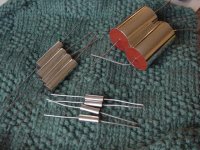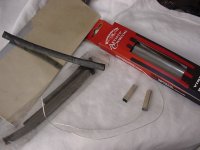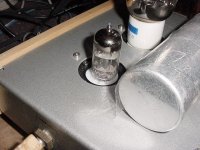Re: relatively OT, sorry
What thermal kinetic energy? If it's the only thing in the universe, then what's acting as the source of the thermal energy impinging upon the capacitor? Unless there's something else in the universe acting as a source for thermal energy, the capacitor will be at absolute zero temperature.
Ok, so discharging the capacitor through some parasitic resistance will convert some of the stored electrical energy into thermal energy. But once that thermal energy has escaped the capacitor in the form of photons, how will that energy be returned to the capacitor? Unless it is, then the capacitor will have the same mass after it's been discharged and the thermal energy dissipates as it did when it was charged.
se
SY said:OK, imagine a Universe with an uncharged capacitor in it as its only object. The capacitor has some value of parasitic resistance in series with it. It has a rest mass mo and an energy mc2, where m takes into account thermal kinetic energy as well as rest mass.
What thermal kinetic energy? If it's the only thing in the universe, then what's acting as the source of the thermal energy impinging upon the capacitor? Unless there's something else in the universe acting as a source for thermal energy, the capacitor will be at absolute zero temperature.
Now, imagine another bizzaro Universe where the same capacitor has a charge Q, and thus a potential energy Q/C. Same rest mass as before. Same parasitic series resistance as before. Same starting temperature, same kinetic energy as before, so by your view the same mass. Now, discharge the cap through the parasitic resistance. Following discharge, the capacitor still has a rest mass m, but there's an increase in thermal energy equivalent to Q/C, the potential converted to kinetic (thus mass). So again by your view, the mass-energy has increased without the cap absorbing anything from the outside (it IS the only object in this Universe). Conservation is violated.
Ok, so discharging the capacitor through some parasitic resistance will convert some of the stored electrical energy into thermal energy. But once that thermal energy has escaped the capacitor in the form of photons, how will that energy be returned to the capacitor? Unless it is, then the capacitor will have the same mass after it's been discharged and the thermal energy dissipates as it did when it was charged.
se
Tom
Please tell us more before the crazies from "another bizzaro Universe" drown us in mindless exchanges of wit.
Please tell us more before the crazies from "another bizzaro Universe" drown us in mindless exchanges of wit.
Hmm, if the capacitor has gained enough mass maybe the light will bend around him? And therefore sound too? 
(you know, protons, neutrons and soundons)

(you know, protons, neutrons and soundons)
The idea came from a post on AA from someone in Europe. It was a response to another thread.
Go to your art supply store and buy Willow stick charcoal. Windsor and Newton is the brand I use. I use a few different sizes bigger is easier. Then cut them to about an inch long for 100 ohm-300ohm. Shorter ones are a little hard to work with. It's a messy job. I then wrap them in silver sheet and epoxy one lead in one end. Then with a meter I adjust the resistance by moving the other end in or out. When its the value I want I epoxy the other end.
I wont bore you with the sound but it's worth all the effort to me.
There are people out there advancing the field but they go almost unnoticed by the masses.
These are the people I steal from.
"...all progress depends on the unreasonable man..."
Not if I can help it.
Go to your art supply store and buy Willow stick charcoal. Windsor and Newton is the brand I use. I use a few different sizes bigger is easier. Then cut them to about an inch long for 100 ohm-300ohm. Shorter ones are a little hard to work with. It's a messy job. I then wrap them in silver sheet and epoxy one lead in one end. Then with a meter I adjust the resistance by moving the other end in or out. When its the value I want I epoxy the other end.
I wont bore you with the sound but it's worth all the effort to me.
There are people out there advancing the field but they go almost unnoticed by the masses.
These are the people I steal from.
"...all progress depends on the unreasonable man..."
Not if I can help it.
Tom,
Now that's the sort of post I hoped to see, bloody cool!
Was that larger silver package a foil capacitor?
Good stuff, thanks for sharing it. And worth *that* kind of effort, and presumably cost, means it must sound pretty decent as well as looking cool!
-Simon
Now that's the sort of post I hoped to see, bloody cool!
Was that larger silver package a foil capacitor?
Good stuff, thanks for sharing it. And worth *that* kind of effort, and presumably cost, means it must sound pretty decent as well as looking cool!
-Simon
Simon,
Yes the two big things are 4.7uf caps. The silver on them is for shielding, it's tied to ground.
Yes the two big things are 4.7uf caps. The silver on them is for shielding, it's tied to ground.
And worth *that* kind of effort, and presumably cost, means it must sound pretty decent as well as looking cool!
I love your reasoning 😀
Tom,
Could you please elaborato on the procedure? I don't get it, I supposse because of my limited english my head seems to be harder than it is.
Could you please elaborato on the procedure? I don't get it, I supposse because of my limited english my head seems to be harder than it is.
Maybe a picture will help.
This shows the packaging of the willow/vine charcoal, the silver sheet, and the silver wire. Just add epoxy and thats all there is to it. It sounds like it can't be this simple but thats it.
The two resistors pictured are unfinished.
Allen Bradley carbon composition resistors come to mind.
Crushing the carbon and compressing it would allow you to make them smaller but I don't like to get that messy.
I'm looking for a good source for insulated fine silver wire to make some bifilar wire wound resistors ala Audio Consulting.
I imagine that is as far as resistors can be taken.
Good luck!
This shows the packaging of the willow/vine charcoal, the silver sheet, and the silver wire. Just add epoxy and thats all there is to it. It sounds like it can't be this simple but thats it.
The two resistors pictured are unfinished.
Allen Bradley carbon composition resistors come to mind.
Crushing the carbon and compressing it would allow you to make them smaller but I don't like to get that messy.
I'm looking for a good source for insulated fine silver wire to make some bifilar wire wound resistors ala Audio Consulting.
I imagine that is as far as resistors can be taken.
Good luck!
Attachments
tom1356 said:Maybe a picture will help.
This shows the packaging of the willow/vine charcoal, the silver sheet, and the silver wire.
-------------------------------------------------------------------
Why is it necessary to use a silver sheet?😕
If you use a brass or aluminum tube instead of the silver sheet,
you could probably jam the charcoal into the tube which would slice off the excess. Then adjust the resisitance by inserting the wire more or less as mentioned. Seems like the connection between the charcoal and the wire is a possiblre weak point of the design.
you could probably jam the charcoal into the tube which would slice off the excess. Then adjust the resisitance by inserting the wire more or less as mentioned. Seems like the connection between the charcoal and the wire is a possiblre weak point of the design.
fmak said:tom1356 said:Maybe a picture will help.
This shows the packaging of the willow/vine charcoal, the silver sheet, and the silver wire.
-------------------------------------------------------------------
Why is it necessary to use a silver sheet?😕
Silver is not necessary, just better.
Before someone asks.
Silver dissapates heat like crazy (very nice for little furnaces like resistors) and makes an excellent shield.
Damn pretty too.
Variac said:If you use a brass or aluminum tube instead of the silver sheet,
you could probably jam the charcoal into the tube which would slice off the excess. Then adjust the resisitance by inserting the wire more or less as mentioned. Seems like the connection between the charcoal and the wire is a possiblre weak point of the design.
Good points. This should make it easier for people to try.
The tubes are longer than the carbon in them to allow for the epoxy to fill it and hold the wire better.
One of the biggest benefits to these resitors is the ability to make the leads as long as necessary and avoid solder joints.
Tomorrow we will discuss DIY solderless teflon tube sockets. 🙂+
Attachments
Thanks, It was very illustrative. I suppose you drill the coal to insert the wire, don't you? Which power can bear those in the picture?
Don't be humble-lazy, and tell us how they sound!!!!
Don't be humble-lazy, and tell us how they sound!!!!
I have never tested them for power handling so I don't know. Before using them in high power applications I would test them.
There is no need to drill anything as the wire is easily pushed in.
If I told you they were the best thing I had ever heard you would learn nothing about their sound.
I would assume better performance from the Audio consulting silver wire wound resistors but I have not heard them or every one of the others.
For clarification my system is a pair of highly modified Consonance 300b mono blocks, a S&B TX-102 based silver TVC passive pre, a highly modified sony CE775 SACD player, an Onkyo tuner, and a pair of DIY line arrays with separate powered DIY subs.
I make my own IC's including the RCA's (both male and female panel mounts). All my components are hard wired on one end.
When I'm done with the resistors I will move to DIY capacitors and the transformers.
None of this means I know what I'm talikng about though.
There is no need to drill anything as the wire is easily pushed in.
If I told you they were the best thing I had ever heard you would learn nothing about their sound.
I would assume better performance from the Audio consulting silver wire wound resistors but I have not heard them or every one of the others.
For clarification my system is a pair of highly modified Consonance 300b mono blocks, a S&B TX-102 based silver TVC passive pre, a highly modified sony CE775 SACD player, an Onkyo tuner, and a pair of DIY line arrays with separate powered DIY subs.
I make my own IC's including the RCA's (both male and female panel mounts). All my components are hard wired on one end.
When I'm done with the resistors I will move to DIY capacitors and the transformers.
None of this means I know what I'm talikng about though.
Anyone know how to wind wire resistors to make then "non-inductive"
Is that what you meant by "bifilar"?
There wqas another thread where someone was making his own caps.
He had a hard time getting the values very high. His highest rating was by compressing the roll in a vise to get closer contact.
Maybe:
roll up foil and film, wrap in fiberglass cloth, dip in epoxy, wrap in waxed paper to keep from sticking, clamp in vise until hard
probably like orange drop caps!
Is that what you meant by "bifilar"?
There wqas another thread where someone was making his own caps.
He had a hard time getting the values very high. His highest rating was by compressing the roll in a vise to get closer contact.
Maybe:
roll up foil and film, wrap in fiberglass cloth, dip in epoxy, wrap in waxed paper to keep from sticking, clamp in vise until hard
probably like orange drop caps!
Hi,
Basically these are two WW Rs in one wound in opposite direction, AKA counterwound.
Do a search on Ayrton-Perry windings for the details on the most common technique.
Cheers,😉
Anyone know how to wind wire resistors to make then "non-inductive"
Basically these are two WW Rs in one wound in opposite direction, AKA counterwound.
Do a search on Ayrton-Perry windings for the details on the most common technique.
Cheers,😉
- Status
- Not open for further replies.
- Home
- Design & Build
- Parts
- Resistor Sound - How is this possible???



